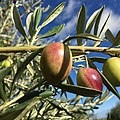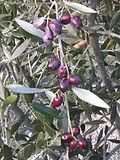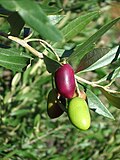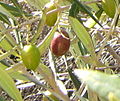List of olive cultivars
There are hundreds of cultivars of the olive (Olea europaea). As one of the oldest and more important domesticated crops raised by humans, the olive tree has diverged naturally and with the assistance of man into many varieties. Olive cultivars are first and foremost divided into their location of origin; most names for cultivars come from place names. Secondarily, olives may be preferred for olive oil production or for eating as table olives, though many cultivars are dual-purpose.
Table of olives
[edit]| Name | Image | Origin | Description | |
|---|---|---|---|---|
| Aglandau (Blanquette, Plant d'Aix, Verdale de Carpentras) |  | France, Australia, Azerbaijan and Ukraine | Known as Beruguette as a table olive. Known as Nichitskaia in Azerbaijan and Ukraine | |
| Aloreña | Spain | The area is primarily in the Valle del Guadalhorce, in the southeast Province of Málaga, in and around 19 towns that include Alhaurin de la Torre, Alhaurín el Grande, Almogia, Álora, Alozaina, Ardales, El Burgo, Carratraca, Cartama, Casarabonela, Coin, Guaro, Málaga, Monda, Pizarra, Ronda, Tolox, Valle de Abdalajís, and Yunquera. The tree produces an egg-shaped table olive similar to an apple in shape and color it is sometimes referred to as the "mini apple".[1] Synonyms: Aloreña, Azufairada, Manzanilla, Manzanilla de Alora, Manzanilla de Los Ranchos, Aloreña de Artafè, Aloreña de Artafè (Aloreña), Aloreña de Artafè (Arola), Aloreña de Iznalloz, Aloreña de Iznalloz (Aloreña). See; Manzanilla.[2] | ||
| Amfissa | Greece | Also called the Amphissis. This is a common Greek table olive grown in Amfissa, Central Greece near the oracle of Delphi. Amfissa olives enjoy protected designation of origin (PDO) status, and are equally good for olive oil extraction. The olive grove of Amfissa, which consists of 1,200,000 olive trees is a part of a protected natural landscape. | ||
| Arbequina |  | Spain | a small, brown olive native to Arbeca, grown in Aragon and Catalonia, Spain, good for eating and for oil. | |
| Arbosana | Spain | a Spanish variety commonly grown for oil production alongside Arbequina and others, including in the United States. | ||
| Ascolano |  | Italy | A cold-hardy table variety from the Le Marche region of Italy enjoyed as a table olive. It is also grown in California for olive oil.[3] When harvested and milled when very ripe the resulting olive oil can exhibit an exceedingly fruity character, described by professional tasters as redolent of tropical fruit and peaches. | |
| Ayvalık | Turkey | Also known as Edremit is popular olive type which is produced mostly for oil. The name is coming from the Turkish cities in North Aegean, Ayvalık – Edremit[4] See: Ayvalık#Olive cultivation. Local naming (synonyms) for the Ayvalık variety: Edremit, Yağık, Şakran, Midilli, Ada Zeytini,[5] and Adremittion.[6] | ||
| Azeradj | Algeria | Early November harvesting produces Azeradj extra‐virgin olive oil with excellent chemical characteristics.[7] | ||
| Barnea |  | Israel | A modern dual-purpose cultivar bred originally from Kadesh Barnea in southern Israel by Professor Shimon Lavee to be disease-resistant and to produce a generous crop. The oil has a strong flavour with a hint of green leaf. Barnea is widely grown in Israel and in the southern hemisphere, particularly in Argentina, Australia, India and New Zealand. It has also been introduced to Northern California. Best pollinizer is the Picual.[8] Also known as K-18 in Al-Jouf, Saudi Arabia,[9] Jordan and Israel.[10] | |
| Beldi | Morocco | Oil cured (soaked in oil), dark brown to black, and wrinkled after curing. | ||
| Biancolilla | Southern Italy, primarily Sicily | The Biancolilla cultivar is one of the most common and one of the oldest produced in Sicily and is used mostly for oils. Its name is because of its change from a light green to a deep wine color at maturity. They don’t require cross-pollination from other cultivars of olives, but are often used by growers of Nocellara del Belice for cross-pollination of those trees, which is sterile without pollination from other cultivars. | ||
| Bidni |  | Malta | Malta's indigenous, disease resistant, cultivar. The fruit is famously known for its superior oil and its beautiful dark violet colour at maturity. | |
| Bosana |  | Italy | the most common olive grown on Sardinia. It is used mostly for oils. | |
| Bouteillan | France | a cultivar grown in France for olive oil. | ||
| Cailletier (Taggiasca) |  | France, Italy | grown primarily in the Alpes-Maritimes region near Nice and in nearby Liguria in Italy, where it is known as Taggiasca. When processed for salads it is known as Niçoise. | |
| Calabria |  | Southern Italy | Grown in the Calabria region, some of these trees can reach sixteen feet in circumference.[11][12] | |
| Canino | Italy | |||
| Carolea | Italy | an olive oil variety grown primarily in Basilicata and Calabria. | ||
| Casaliva | Italy | |||
| Castelvetrano | See: Nocellara del Belice | |||
| Cayon | France | an olive oil variety grown in Southern France. | ||
| Cellina di Nardo | Italy | |||
| Cerasuola |  | Southern Italy, primarily Sicily | The cerasuola cultivar is common in Sicily, especially in the Province of Trapani in Western Sicily. It is used for oils and has a high yield, often above 20%. They are drought resistant, an important feature in Sicily where there is often little or no rain from late May until the end of September. It is self-sterile, so needs cross-pollination from other cultivars in order to produce. Other common western Sicilian olives are used for this, primarily the Biancolilla and Nocellara del Belice cultivars | |
| Cerignola |  | Italy | originates from the south-eastern Italian province of Apulia, are very large, mild in flavor, and may be served either green or cured red or black. | |
| Chemlali | Tunisia | |||
| Chetoui | Tunisia | |||
| Cobrançosa | Portugal | a variety cultivated in Portugal. | ||
| Conservolea | Greece | a table olive cultivar, a mainstay of the Greek olive industry, same to Amphisis | ||
| Coratina (Coratina Dolce Agogio) |  , ,  | Italy, Croatia | One of the most important Italian varieties, especially favoured in the area of Puglia, the largest olive growing area of Italy and also available in Argentina, Australia, and Northern California. This olive has a naturally high level of polyphenols, which yield a robust tasting olive oil. "Synonyms": A Racemi, Belmonte, Cima di Corato, Coratese, Grappola, Grappolina, La Valente, Olivo A Grappoli, Olivo A Raciuoppe, Racemo, Racioppa, Racioppa di Corato, Racioppo,[13] | |
| Cornicabra | Spain | originating in Toledo, Spain, comprises about 12% of Spain's production. It is mainly used for oil. It is the main variety of olive used to make olive oil in Algeria.[14] | ||
| Domat | Turkey | a common Turkish green olive, a table olive and grown for oil[4][15] | ||
| Dritta | Italy | a variety of olive tree typical of the DOP area known as Aprutino Pescarese in the province of Pescara (Abruzzo). Its olives yield an extra virgin olive oil featuring extraordinary chemical and organoleptic qualities. | ||
| Empeltre |  | Spain | a medium-sized black olive grown in Spain, especially along the Ebro Valley and the Balearic Islands. It is dual-purpose, though mainly for oil. | |
| Frantoio |  | Italy | Along with Leccino, Frantoio olives are a principal raw material for Italian olive oils from Tuscany. Frantoio is fruity with a stronger aftertaste than Leccino. | |
| Galega | Portugal | Also known as Galega Vulgar, is a variety cultivated in Portugal. | ||
| Gemlik | Turkey | a variety from the Gemlik area of northern Turkey. They are small to medium-sized black olives with a high oil content. This type of olive is very common in Turkey and is sold as a breakfast olive in the cured formats of either Yagli Sele, Salamura or Duble, though there are other less common curings. The sign of a traditionally cured Gemlik olive is that the flesh comes away from the pit easily. | ||
| Gentile di Chieti (Nostrana) | Italy | Italian variety typical of Abruzzo region | [16] | |
| Germaine | Corsica, Italy | Also: Ghjermana (Ghjermana de Balagne), Ghermana or Germana. Dual purpose, resistance to cold weather, 30% high yield, and black when ripe. | ||
| Gordal (Queen olive) | Seville and Andalusia, Spain | Table olive. The name means "the fat one" because of the large size.[17] | ||
| Grossane | France | |||
| Halkidiki | Greece | very large table olives from the Halkidiki region of Greece; also called gaidouria, donkey olives[18] | ||
| Hojiblanca |  | Spain | native to Lucena in the province of Córdoba, Spain; its oil is widely appreciated for its slightly bitter flavour. | |
| Hondroelia | Greece | ('hondro=thick' olive, due to its size), a rare olive from Astros, blond, traditionally cured in salt[18] | ||
| İzmir Sofralık | Turkey | a Turkish olive mostly grown for olive oil[4] | ||
| Kalamata |  | Greece | a large, black olive with a smooth and meatlike taste, is named after the city of Kalamata, Greece, and is used as a table olive. These olives are usually preserved in wine, vinegar or olive oil. Kalamata olives enjoy PDO status, and olives of this same cultivar grown outside the Kalamata region are marketed in the EU as Kalamon olives.[18] | |
| Koroneiki |  | Greece and other areas | originated from the southern Peloponnese area, around Kalamata and Mani, in Greece. This small olive, though difficult to cultivate, has a high yield of olive oil of exceptional quality. Also known as Koroni, Kritikia, Ladolia, Lianolia, Psilolia, and Vaciki[19] | |
| Kothreiki | Greece | a dual-purpose cultivar for oil and table olives | ||
| Lechín de Sevilla (also Ecijana or Zorzaleña) | Spain | Ranked fourth in terms of land coverage with 190,000 hectares (470,000 acres). This is an important variety in Andalusia, predominantly in the province of Seville. It is also cultivated in the bordering provinces of Cordoba, Cadiz, and the Málaga. The oil has a fruitiness with the presence of green, bitter, light almond, and pungent attributes that is slightly astringent and smooth on the palate.[20] | ||
| Leccino |  | Italy | Along with Frantoio cultivars, Leccino olives are the principal raw material for Italian olive oils from Tuscany. Leccino has a mild sweet flavour. | |
| Lugano | Italy | |||
| Lucques |  | France | found in the south of France (Aude département). They are green, large, and elongated. The stone has an arcuated (bow) shape. Their flavour is mild and nutty. | |
| Maalot | Israel | (Hebrew for merits) is a disease-resistant, Eastern Mediterranean cultivar derived from the North African Chemlali cultivar in Israel. The olive is medium-sized, round, has a fruity flavour and is used almost exclusively for oil production. | ||
| Manzanilla |  | Spain | a large, rounded-oval fruit, with purple-green skin, originated in Dos Hermanas, Seville, in southern Spain. "Manzanillas" means little apples in Spanish. Known for a rich taste and thick pulp, it is a prolific bearer, grown around the world. Cross breeding: Hybridization of the Picholine and Manzanillo (Bellini et al. 2002b) resulted in the newer cultivars Arno, Tevere, and Basento.[21] | |
| Mastoidis | Greece | A Greek table olive cultivar similar to Tsounati.[22] | ||
| Megaritiki | Greece | a dual-purpose cultivar for oil and table olives | ||
| Memecik | Turkey | Main cultivar of the Aydin Province in the Aegean Region also grown in the Mugla Province (Milas) and some districts of Izmir Province. Synonyms: Tas, Arası, Aşıyeli, "Gülümbe", "Şehir", and "Yağlık".[5] | ||
| Memeli | Turkey | a Turkish olive used for split green olives, green olives in brine, black olives and olive oil. Clingstone.[4] | ||
| Meslalla | Morocco | a Moroccan green olive used for olive oil production, pickled in garlic and hot peppers. It is also used in tagines. | ||
| Mission |  | United States | originated on the California Missions and now grown throughout the state. They are black and generally used for table consumption.[23] | |
| Morrut (Morruda and Regués) | Spain | Grown in the region of Montsià-Baix Ebre, in the province of Tarragona, and the northern part of Castellón, the fruit exhibits spiciness and a slight bitterness with almond and green apple flavours. This variety, along with Sevillenca and Farga are under the Oil of Baix Ebre-Montsía Designation of Origin. Morrut is not as hearty as other varieties being sensitive to cold and drought. There has not been much expansion with only about 30,000 hectares (74,000 acres).[24] | ||
| Nabali | Israel | originated in Israel[25] and is known locally as Baladi, It is also used widely in Israel, Jordan and the Hauran region in southern Syria. | ||
| Nafplion | Greece | a small green olive grown only in the Argos valley in Greece. Nafplion olives are traditionally cracked and cured in brine.[26] | ||
| Nevadillo Blanco | See: Hojiblanca | |||
| Niçoise (See: Cailletier) | France | Grown around Nice and French Riviera | ||
| Nocellara del Belice |  | Italy | a large green olive cultivar primarily grown in Sicily. Also known as Castelvetrano olives in the United States, they have a mild, buttery flavor that makes them popular table olives, though they are also used to produce olive oil. | |
| Nocellara Etnea (also Augghialora, Paturnisa, and Tortorella) | Apulia and central and eastern part of Sicily | 16% oil yield with 0.6% acidity, leaves are medium-sized lanceolate and slightly tapered. Taste is fruity with organoleptic properties of green tomato, leaf of grass, almond, thistle, or artichoke[27] | ||
| Nyons |  | South of France | The first olive cultivar in France to receive the Appellation d’Origine Contôlée (AOC) accreditation in 1994. To be designated Nyons Olives, the olive must be of the Tanche variety, and grown within the specified AOC (Now AOP) zone.[28] | |
| Oliana
| Spain | |||
| Olivière | France | |||
| Patrinia | Greece | a Greek variety of olive tree grown primarily in Aigialeia, Greece, and in Farres region of West Achaia. | ||
| Picholine |  | France | grown in the south of France. It is green, medium size, and elongated. The flavour is mild and nutty. | |
| Picual |  | Spain | from southern Spain (province of Jaén), is the most widely cultivated olive in Spain, comprising about 50% of Spain's olive production and around 20% of world olive production. It has a strong but sweet flavour, and is widely used in Spain as a table olive. With the global cultivation of the tree there are many subvarieties and synonyms. | |
| Ravece, also known as Rotondela | Italy | DOP designation[29] | ||
| Sabine olive | France | |||
| Salkini | Syria, Lebanon, Jordania | |||
| Salonenque | France | |||
| Sevillano | Spain, California | Synonyms: Callosina (Callolina, Cornicabra, Cornicabra Blanco, Cornicabra Parda, Cornicabra Parda de Villena, Picúa, Yeclana) [30] Campanil (Campanillo, Campanita, Campanita de Ecija, Manzanilla, Manzanilla Real, Manzanilla Cordobés, and Sevillano),[31] Caspolina (Gordal Sevillana, Basta, and Sevillana de Caspe),[32] Gordal Sevillana (Branquita, Forna, Manzanera, Manzanet, Manzaneta, Manzanilla de la Rivera, Mochonenca, Vall de Gallinera, Vall de Gallinera, and Vall de Gallinera), Villalonga[33] Manzanilla Prieta (Bolondo, Manzanilla Basta, Manzanilla Negra, Manzanilla Serrana, Manzanilla Cordobí, Manzanilla Fino, Morisca, Perillo, Perito, Picudo, Varetuda), Pico Limón (Pico Limón de Grazalema, Morisca, Manzanilla del Piquito, Pico Cuervo and Nevadillo de Madridejos), Picual, Sevillano de Jumilla, and Villalonga,[34][35] | ||
| Sevillenca (Serrana) | Spain | Synonyms: Falguera in Castellón and Valencia, Mas de Bot or Morrudel in Tarragona, also in Valencia referred to as Serrana de la Sierra, or Serraneta in Valencia, Sevillenc or Solivenc in Tarragona, and Serrana, or Serrana de Espadán in Castellón, Tarragona, Teruel, and Valencia[36] where it has been awarded Protected Designation of Origin (PDO) status especially in the Serra d'Espadà and Sierra Calderona areas,[37] and exported to the UK, Italy, Germany, France, Austria, Luxembourg, Belgium, the Netherlands, Denmark, Poland, Czech Republic, Hungary, Switzerland, Ireland, Slovakia, Slovenia, Romania, Lithuania, Latvia, Estonia, Finland, Bulgaria, Greece, Sweden, Croatia, Norway, and Serbia.[38] | ||
| Chiquitta | Spain | |||
| Souri | Lebanon | Named after the town of Sur (Tyre) and mainly cultivated in Southern Lebanon and Northern Israel. It is also relatively widespread in the rest Levant, has a high oil yield and exceptionally aromatic flavour. | ||
| Swan Hill Olives® | Australia | Much grown as an ornamental for producing virtually no allergenic pollen or dropped fruit;[39] cultivar registered as trademark of Devil Mountain Tree Company, LLC[40] | ||
| Tanche |  | France | Dual-use black olive with a yield of 22–25% | |
| Thassos |  | Greece | the only cultivar that can be eaten straight from the tree when ripe.[18] | |
| Throumbolia | Greece | a dual-purpose cultivar for oil and table olives | ||
| Tsounati | Greece | see Mastoidis | ||
| Verdale-de-l'Hérault | France | |||
| Verdial | Spain |
See also
[edit]References
[edit]- ^ Aloreña Olive of Malaga: Slow Food Foundation for Biodiversity- Retrieved 2018-06-11
- ^ Olea Database: Aloreña- Retrieved 2018-07-09
- ^ Vossen, Paul. "Growing Temperate Tree Fruit and Nut Crops in the Home Garden and Landscape" (PDF). University of California Cooperative Extension. Archived from the original (PDF) on 2021-03-01. Retrieved 2013-11-15.
- ^ a b c d "Olive Growing in Turkey" (PDF). Körfez Grubu. Archived from the original (PDF) on 2013-05-23.
- ^ a b Gökçebağ, Mümtaz; Dıraman, Harun; Özdemir, Durmuş (2013). "Classification of Turkish Monocultivar (Ayvalık and Memecik cv.) Virgin Olive Oils from North and South Zones of Aegean Region Based on Their Triacyglycerol Profiles" (PDF). Journal of the American Oil Chemists' Society. 90 (11): 1661–1671 [1662]. doi:10.1007/s11746-013-2308-y. S2CID 97513870. Archived from the original (PDF) on 2018-07-10. Retrieved 2018-07-10.
- ^ Peas Health: Adremittion Archived 2019-05-24 at the Wayback Machine- Retrieved 2018-07-13
- ^ Bakhouche, Abdelhakim; Lozano-Sánchez, Jesús; Bengana, Mohamed; Fernández-Gutiérrez, Alberto; Segura-Carretero, Antonio (2015). "Time course of Algerian Azeradj extra-virgin olive oil quality during olive ripening". European Journal of Lipid Science and Technology. 117 (3): 389–397. doi:10.1002/ejlt.201400197.
- ^ Shemer, A.; Biton, I.; Many, Y.; Vaknin, Y.; Lavee, S.; Avidan, B.; Ben-Ari, G. (2014). "The olive cultivar 'Picual' is an optimal pollen donor for 'Barnea'". Scientia Horticulturae. 172: 278–284. Bibcode:2014ScHor.172..278S. doi:10.1016/j.scienta.2014.04.017.
- ^ Olea Database: Barnea- Retrieved 2018-07-10
- ^ "Oil Characteristics of Four Palestinian Olive Varieties". www.jstage.jst.go.jp. Retrieved 12 July 2018.
- ^ Teatro Naturale- Retrieved 2018-06-11
- ^ Calabria olive tree- Retrieved 2018-06-11
- ^ Olea Database: Coratina- Retrieved 2018-07-09
- ^ "Common Olive Varietals by Country". About Olive Oil. Retrieved 10 July 2015.
- ^ İsfendİyaroğlu, Murat & Özeker, Elmas (2012). "Root Regeneration of 'Domat' Olive (Olea europaea L.) Cuttings: Wounding Effects" (PDF). Ege Üniversitesi Ziraat Fakültesi.
- ^ Antognozzi, E.; Standardi, A. (1978). "Studio della biologia fiorale negli olivi "Gentile di Chieti" e "Dritta di Moscufo"" [Study of flower biology in the olive trees "Gentile di Chieti" and "Dritta di Moscufo"]. Rivista di Ortoflorofrutticoltura Italiana (in Italian). 62 (5): 461–469. JSTOR 42878264.
- ^ Philosophy Foods: Gordal olive- Retrieved 2018-07-02
- ^ a b c d Fotiadi, Elena (2006). "Unusual Olives". Epikouria Magazine (2). Archived from the original on 2014-12-07.
- ^ Olea Database: Koroneiki- Retrieved 2018-07-08
- ^ Oliveoilsofspain.org: Lechín de Sevilla- Retrieved 2018-06-12
- ^ Vollmann, Johann (and Rajcan, Istvan ) (2009). Oil Crops. UC Olive Center. p. 408. ISBN 9780387775944.
{{cite book}}: CS1 maint: multiple names: authors list (link) - ^ Sinha, N.; Hui, Y.H.; Evranuz, E.Ö.; Siddiq, M.; Ahmed, J. (2010). Handbook of Vegetables and Vegetable Processing. Wiley. p. 664. ISBN 9780470958445.
- ^ Soleri, D.; Koehmstedt, A.; Aradhya, M. K.; Polito, V.; Pinney, K. (1 October 2010). "Comparing the historic olive trees (Olea europaea L.) of Santa Cruz Island with contemporaneous trees in the Santa Barbara, CA area: a case study of diversity and structure in an introduced agricultural species conserved in situ". Genetic Resources and Crop Evolution. 57 (7): 973–984. doi:10.1007/s10722-010-9537-9. S2CID 9391240.
- ^ Oliveoilsfromspain.org: Morrut olive- Retrieved 2018-06-12
- ^ a., Belaj; z., Satovic; l., Rallo; i., Trujillo (2002). "Genetic diversity and relationships in olive (Olea europaea L.) germplasm collections as determined by randomly amplified polymorphic DNA". Theoretical and Applied Genetics. 105 (4): 638–644. doi:10.1007/s00122-002-0981-6. PMID 12582515. S2CID 21091953.
- ^ Zingermans
- ^ Nocellara Etnea- Retrieved 2018-07-05
- ^ "Olives - Taste of our Provence - Vignolis".
- ^ Ravece olive oil- Retrieved 2018-07-03
- ^ Callosina- Retrieved 2018-07-16
- ^ Database: Campanil - Retrieved 2018-07-16
- ^ Olea Database: Caspolina- Retrieved 2018-07-16
- ^ Olea Database: Villalonga- Retrieved 2018-07-16
- ^ Olea Database: Manzanilla Prieta- Retrieved 2018-07-16
- ^ Olea Database: Sevillano- Retrieved 2018-07-16
- ^ Olea Database: Sevillenca- Retrieved 2018-07
- ^ Valencia area: PDO
- ^ Olive Club: Export of Serrana Espadán
- ^ "Search Tree Collections".
- ^ "SWAN HILL OLIVES Trademark of DEVIL MOUNTAIN WHOLESALE NURSERY, LLC - Registration Number 2001332 - Serial Number 74733864 :: Justia Trademarks".
Further reading
[edit]- Diego Barranco Navero, ed. (2000). World Catalogue of Olive Varieties. International Olive Oil Council. ISBN 978-8493166311.


 French
French Deutsch
Deutsch